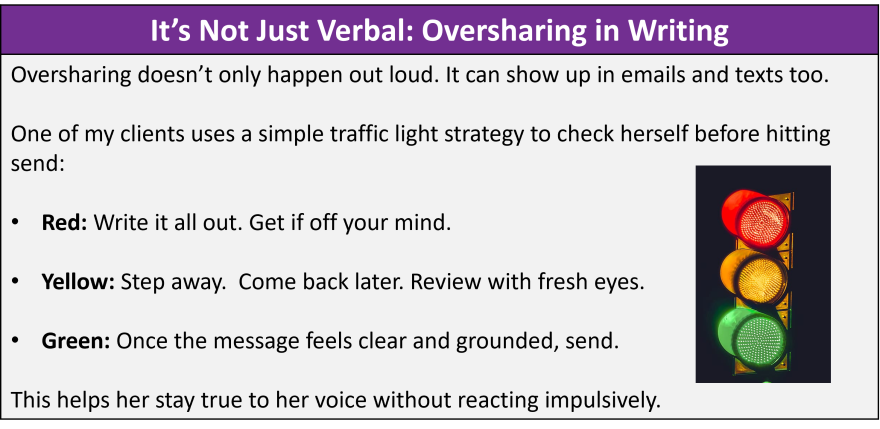|
We’ve all had those moments. You walk away from a conversation and immediately start replaying it in your head. The words came out fast, and now you’re sitting with regret or that all-too-familiar feeling of shame. You shared too much, and you know it.

Oversharing often comes from a good place. We want to be real, connect, and show we care. But when we’re not tuned into the moment, that openness can cross a line and leave us feeling exposed. Some of us may also miss or misread subtle cues, like moments when someone’s interest fades or the mood shifts. Missing these cues makes it harder to tell how much is okay to share. And sometimes, we don’t even realize we overshared until afterward.
If you resonate with this narrative, you're not alone. Oversharing isn't a moral failure, it's something many of us do, especially under stress or uncertainty.
This is where active listening comes in. Not just as a communication skill, but as a tool for staying present.
What Does Active Listening Have To Do With Oversharing?
More than you might think.
Oversharing often happens when we’re in our own heads. We might be thinking fast, feeling pressure, or trying to connect quickly. Active listening shifts that inward focus. It gives the brain something else to track: the other person’s words, tone, and body language.
When we pay attention in this way, it becomes easier to stay in the moment. Even a brief pause can be enough to ask, “Do I want to share this right now?”
Practicing active listening builds awareness. That awareness can create just enough space to make a different choice and avoid oversharing.
Active Listening 101
I completed a year-long Co-Active Leadership training that introduced me to the three levels of listening. It’s a framework that builds presence, connection, and responsiveness in conversation. Learning to listen this way can reduce the urge to overshare by shifting your focus to the other person, the present moment, and the flow of the conversation.
The Three Levels of Listening
- Level 1: Internal listening. You hear the other person, but your attention is mostly on yourself. How do I feel about what they’re saying? What will I say next?
- Level 2: Focused listening. You're deeply attuned to one person. You're tracking their words, tone, and body language. Your attention is fully on them.
- Level 3: Global listening. This level expands your focus. You’re still tuned into the person, but you’re also aware of the environment and how your own body is responding. You might notice the mood in the room or a feeling of tension or calm. The goal is not to analyze, but to notice without jumping to conclusions.
Note: We all move between these levels. Active listening happens in Levels 2 and 3. The goal isn’t to stay in one level, but to notice where you are and shift with intention. When you notice your attention drifting inward or you're planning your next words, try shifting to level 2 by fully focusing on the other person. At times, it helps to expand to Level 3, tuning into the environment and how you're feeling. Practicing these shifts helps you stay present and respond with more balance, which can ease the desire to overshare.
Active Listening Tips
If staying present is hard (and it often is), here are a few strategies to support deeper listening:
- Lip mirroring: Watching the speaker’s lips can help anchor your attention to what’s being said and reduce mental wandering.
- Intentional eye gaze: If direct eye contact feels too intense, try looking at the speaker’s nose or chin. You’ll still stay visually engaged.
- Fidget or ground quietly: Holding a small object or noticing your feet on the floor can help regulate your nervous system and steady your focus.
-
Pre-regulate when possible: If you know a conversation might be socially or emotionally demanding, take a moment to breathe, stretch, or have some water. These small acts can help you settle and stay focused.

A Check-In Question
Before you share something personal, try asking yourself:
“Is this the time, the place, and the person for this story?”
This one pause can make a difference. It invites you to check in on three things:
- Timing. Are we in the middle of something else?
- Context. Is this a casual chat, a professional space, or something in between?
- Relationship. Is this someone I know well, or someone I’m still getting to know?
I can already hear some of you saying, "Ana, if I had time to ask myself all that, I wouldn’t have overshared."
That’s totally fair.
The truth is, we don’t always have time to pause. That moment between thought and speech can be incredibly fast, especially when we’re excited, anxious, or just trying to ease the awkwardness.
But even knowing this question exists can build awareness. And that awareness is what eventually gives us access to choice, even if it’s just a few more seconds of awareness than before.
That’s where grounding strategies come in. They give your body and brain something to focus on so you can stay connected to the moment instead of reacting automatically. Grounding supports active listening, and it can also give you just enough space to catch yourself before oversharing.
A Few Grounding Cues You Can Try
- Use a grounding anchor: Lightly touch a bracelet (or ring, watch, etc.) or imagine a mental post-it note that says, “What’s my point?” These quiet cues can prompt a moment of pause before speaking.
- WAIT reminder: A red sticker on a water bottle or laptop with “WAIT” (short for “Why Am I Talking?”) can serve as a gentle nudge to check in: Is this helpful? Is it needed?
- Silent phrase: Repeat something like “Short and true” or “Say less, listen more.” These mantras help you pause long enough to decide what’s worth sharing.
- Breathe first: One slow breath can be enough to interrupt the reflex to overshare.
Self-Correction Without Shame
If you do catch yourself mid-ramble or right after oversharing, you don’t need to backpedal or apologize ten times. A simple, comment like, “I may have gone a little long there,” or “Anyway, thank you for listening,” can be said out loud to acknowledge the moment without shame. Then move on. That’s it. You’re allowed to self-correct without spiraling.
And Finally… Be Kind to Yourself
Even with structures like listening levels, grounding tools, and the traffic light or post- it techniques in place, there will be moments when you share more than you meant to. Moments when you hit send too soon. Mornings you wake up thinking, “Why did I say that?”
Those moments are when your self-talk and self-compassion become the most important tools in the box.
It’s not about perfection. It’s about building awareness, taking care of yourself, and remembering that one conversation or email doesn’t define you.
With gratitude,
Ana Isabel Sánchez
  
|